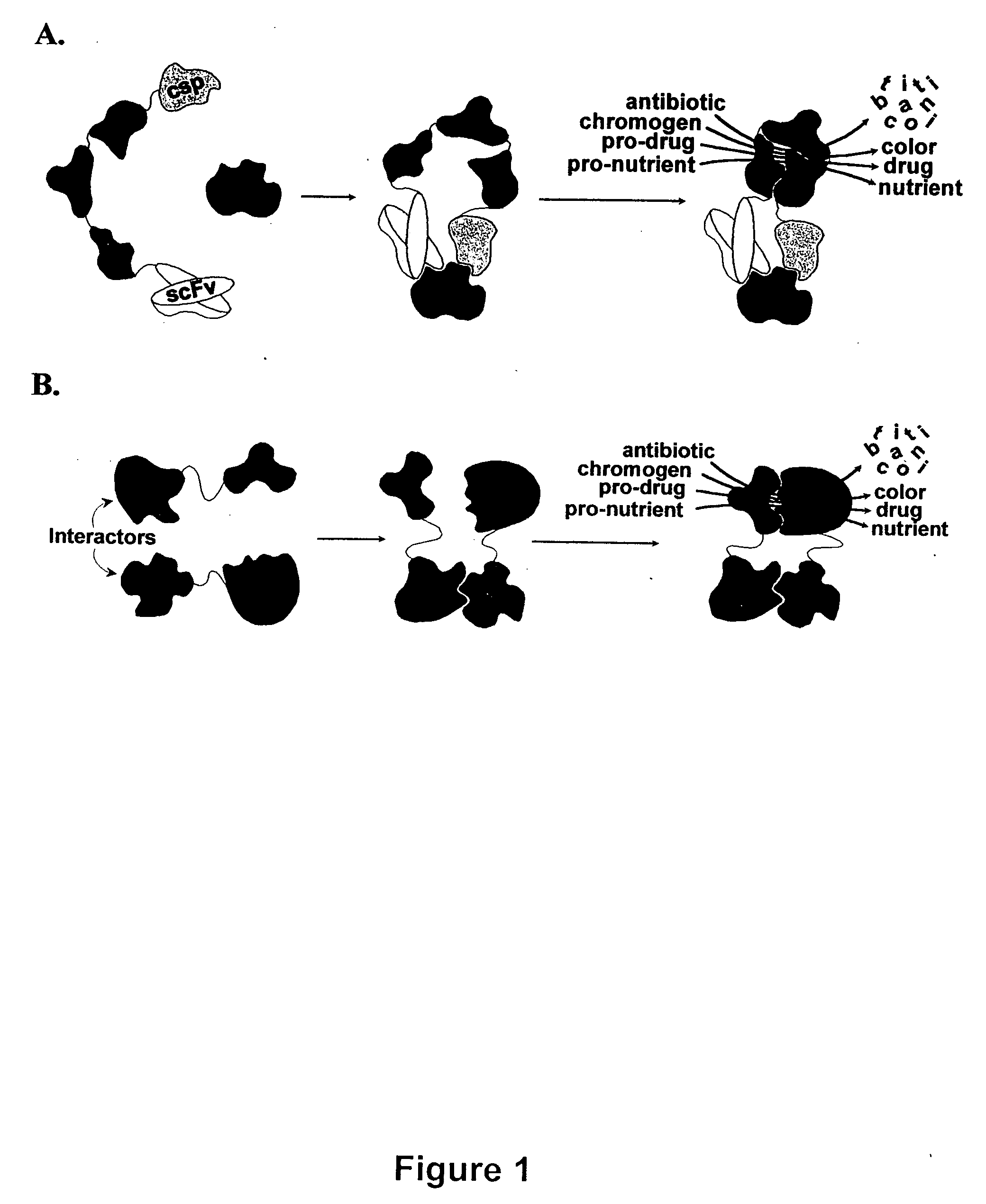Breakpoint fusion fragment complementation system
- Summary
- Abstract
- Description
- Claims
- Application Information
AI Technical Summary
Problems solved by technology
Method used
Image
Examples
example 1
.beta.-lactamase Activation by Interaction-Mediated Complementation of .alpha.197 and .omega.198: Interactions Between ScFv and Trxpeps
[0072] This example demonstrates the ability of the system to detect and discriminate specific interactions between single-chain antibody Fv fragments (scFv) and 12-amino acid peptides by inserted into the active site of E. coli thioredoxin (trxpeps, Colas et al., Nature (1996) 380:548). ScFv are comprised of antibody heavy chain and light chain variable regions (VH and VL) tethered into a continuous polypeptide by most commonly a (Gly.sub.4Ser).sub.3 linker encoded between most commonly the C-terminus of VH and the N-terminus of VL.
[0073] ScFv from a human non-immune antibody repertoire were amplified by PCR using consensus primer mix (Marks et al., Eur J Immunol (1991) 21:985), and subcloned into a pUC119-based phagemid vector (Sambrook et al., supra) for expression of the scFv as fusions to the N-terminus of the .omega.198 fragment with an interve...
example 2
.beta.-lactamase Activation by Interaction-Mediated Complementation of .alpha.197 and .omega.198: Interactions Between Antibody Light Chain V-Regions (VL) and Trxpeps
[0076] This example demonstrates the ability of the system to work with larger antibody fragments, such as Fab, which are comprised of entire light chains disulfide-bonded to Fd fragments which contain VL plus the first heavy chain constant region. A subset of Fabs from a human repertoire library was subcloned for expression as C-terminal .omega.198 fusions from a dicistronic transcript from the lac promoter in the pAO1 vector (see FIG. 6A). The first cistron encoded the light chain with a signal peptide for translocation to the periplasm. The light chain termination codon was followed by a short spacer sequence and then a ribosome, binding site approximately 10 bp upstream from the start of translation for the signal peptide of the Fd fragment, which was followed by .omega.198 with an intervening (Gly.sub.4Ser).sub.3 l...
example 3
.beta.-lactamase Activation by Interaction-Mediated Complementation of .alpha.197 and .omega.198: Interactions Between CD40 and Trxpeps
[0079] This example demonstrates the ability of the present system to isolate panels of trxpeps that bind to a given protein of interest, and which could be used to map interaction surfaces on the protein, and which could also assist in the identification of new ligands by homology. The extra-cellular domain of the human B-cell activation antigen CD40 is known to reliably express in the E. coli periplasm (Noelle et al., Immunol Today (1992) 13:431; Bajorath and Aruffo, Proteins: Struct, Funct, Genet (1997) 27:59). A T-cell surface molecule, CD40 ligand (CD40L), is known to co-activate B-cells by ligation to CD40, but there may be other ligands. Therefore, TEM-1 .alpha.197 / .omega.198 fragment complementation was used to select a panel of CD40-binding trxpeps. The sequences of these peptides would then be examined for homology to the known ligand and o...
PUM
| Property | Measurement | Unit |
|---|---|---|
| Fraction | aaaaa | aaaaa |
| Fraction | aaaaa | aaaaa |
| Density | aaaaa | aaaaa |
Abstract
Description
Claims
Application Information
 Login to View More
Login to View More - R&D
- Intellectual Property
- Life Sciences
- Materials
- Tech Scout
- Unparalleled Data Quality
- Higher Quality Content
- 60% Fewer Hallucinations
Browse by: Latest US Patents, China's latest patents, Technical Efficacy Thesaurus, Application Domain, Technology Topic, Popular Technical Reports.
© 2025 PatSnap. All rights reserved.Legal|Privacy policy|Modern Slavery Act Transparency Statement|Sitemap|About US| Contact US: help@patsnap.com



